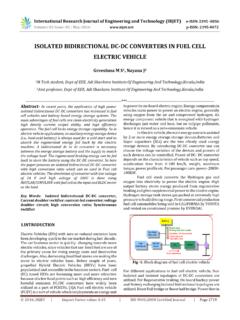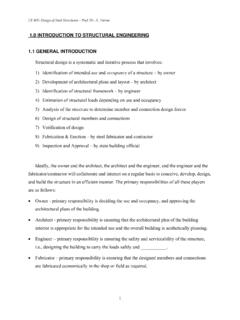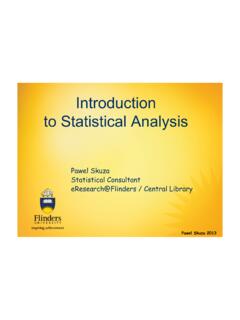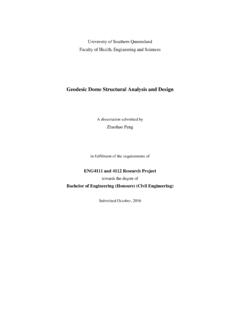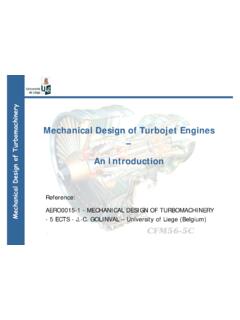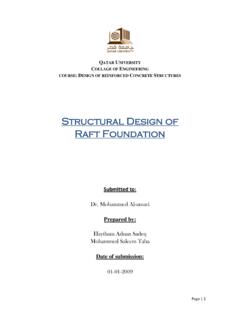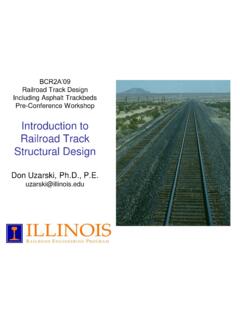Transcription of DESIGN AND STRUCTURAL ANALYSIS OF WIND TURBINE …
1 International Research Journal of Engineering and Technology (IRJET) e-ISSN: 2395-0056 Volume: 08 Issue: 01 | Jan 2021 p-ISSN: 2395-0072 2021, IRJET | Impact Factor value: | ISO 9001:2008 Certified Journal | Page 1284 DESIGN AND STRUCTURAL ANALYSIS OF WIND TURBINE TOWER MALLIKARJUN1, CHANDAN R2, Dr. SHIVAPPA H A3, BYREGOWDA K C4, PREETHI K5 Student, Dept. of Mechanical Engineering, Dr. Ambedkar Institute of Technology, Bengaluru, India 2-5 Asst. Professor, Dept. of Mechanical Engineering, Dr. Ambedkar Institute of Technology, Bengaluru, India ---------------------------------------- -----------------------------**--------- ---------------------------------------- ---------------------Abstract - The wind turbines are used to convert the wind energy into electrical energy.
2 Wind turbines are mounted at the top of the vertical structure called Wind Tower . Increasing demand of high power generation in is compelling the towers to be made taller and stiffer, so as to catch strong winds at higher altitudes. It mainly focuses on designing a wind tower for Uttar Kannada, the Western Ghats of Karnataka State, which is one of the potential sources of wind energy. The main objective is to find the high strength material for wind TURBINE tower. Geometric DESIGN of the 2MW power generation wind TURBINE tower is carried out in CATIA V5 and analyzed in ANSYS Workbench for STRUCTURAL steel, Alloy steel 4130, and Alloy steel 6150 materials. STRUCTURAL ANALYSIS , modal ANALYSIS and fatigue life estimation is performed and results are validated.
3 Hence From the results we can conclude that Alloy steel 6150 is safe and economic for DESIGN when compare to other materials. Key Words: Wind energy, Power generation, High strength, CATIA V5, ANSYS Workbench. 1. introduction As the growth of the economy of the country increases, the energy requirement also increases. Burning of the fossil fuels will affect the environment by releasing greenhouse gas, to avoid the environmental pollution, we need to reduce dependency on fossil fuels, and hence few alternative method of generation power is needed. Therefore, to meet the demand of the power requirement and also being friendly to the environment these renewable energy resources are used for power generation like wind energy, solar energy, tidal energy etc.
4 Wind is the one of the renewable energy resources which pays a major role and freely available resources for the power generation. The cost of the electricity produce from the wind energy has successfully reduced to over the past 15 years in the wind industries. Over the past few decades, the wind industries for power generation had been built all over the world. Due to the shortage of electricity is getting common in the busy dynamic worlds. Over all about 40% world population has no access between the modern energy services. The demand in the electricity in India is going to be expected three times more than the expected demand over the year 2005 to 2030. In the year 2011, India had new record in installing more than 3GW of new capacity wind towers between the months of January to December.
5 As of September 2014, India total capacity of installed renewable energy accounts for , up from 2% in 1995. From the above it is clear that the next few years, w e could see major increase in wind farm activities. Wind tower failures As the number turbines towers increases, the number of accidents occurring is also increasing day to day from the survey in the recent decades. From the last 20 year s survey shows that, with an average of 16 accidents per year from 1995-99 inclusive; 48 accidents per year from 2000-2004 inclusive; 108 accidents per year from 2005-09 inclusive, and 155 accidents per year from 2010-14inclusive. As official information releases up to 31 December 2014.
6 Foundation failure There are three types of cracking are occurred in the wind tower foundation; one type is the cracking of the mortar grout between the connection flange and the concrete foundation. This type of cracking occurs in the foundation by the negligence in the workmanship and also in poor selection of material. The second type is the cracks which are observed in the high pedestals, pedestals with a height of about 4 to 8 m. The cracks are caused by poor STRUCTURAL DESIGN . This cracks are leads to foundation failure in the concrete steel interface by crack propagation due to the cyclic loading on the tower, further soil bearing force also causes the foundation failure.
7 Tower failure in flange fillet and welded region Due to the uneven loading failure occurs in the flange result in bending stress in the fillets, weld, and tower shell. The weld region may fail due to the high bending stress in the fillet region which leads to STRUCTURAL failure. International Research Journal of Engineering and Technology (IRJET) e-ISSN: 2395-0056 Volume: 08 Issue: 01 | Jan 2021 p-ISSN: 2395-0072 2021, IRJET | Impact Factor value: | ISO 9001:2008 Certified Journal | Page 1285 2. LITERATURE SURVEY Murtagh, Basu [1] In this paper the authors has studied the vibration of the wind TURBINE towers effects the soil structure interface in the model.
8 They have identified that the incorporating the flexibility of the soil in the model which determines a considerable amount of damping in the wind tower system. This suggests the calculations of natural frequency that do not consider damping due to soil structure interaction which may lead to the un realistic and un economical DESIGN . Silva, Arora [2] In this paper the authors have discussed on the dynamic ANALYSIS of reinforced concrete slender structures. This is based on the nonlinear model with experimental data. Furthermore, optimization of constraints has been transcribed in this model and applied it to the optimal DESIGN of reinforced concrete wind TURBINE towers.
9 B Gencturk, A Attar et al [3] In this paper the authors have discussed on the DESIGN optimization of lattice wind TURBINE towers subjected to earthquake forces. The selection of height and size of the TURBINE is one of the key aspects in optimizing the cost of installation wind tower based on the wind farm location. For about 10 towers size and combinations of height is compared and validated based on the cost. The ANALYSIS is carried out in the case study of the earthquake region and seismic forces which are also involved in the tower ANALYSIS . The obtained results data will provide direct insight on the selection of the optimal tower considering height and size of the TURBINE despite from the effect of total number of towers in the farm and location.
10 B Song, J C [4] in this paper the authors have discussed on comparative ANALYSIS on dynamic response of wind TURBINE tower in different sites. In this comparative ANALYSIS authors have considered the height of the tower about 50m and tall respectively based on the mountain and offshore different types of environmental condition in different sites. By maintaining the Japanese standard behavior of bearing and combinations of loads are analyzed for various kinds of TURBINE towers. Dynamic response of the structure is studied for higher levels of earth quick conditions based on the height, displacement and quality of the towers. So, from the conclusion we come to know that dynamic response of the structure is majorly affected by height of the tower in different sites.







